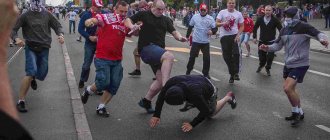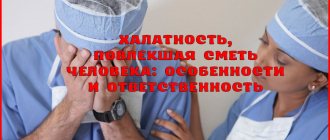Corpus delicti
The corpus delicti under Article 116 of the Criminal Code of the Russian Federation arises when the following conditions are simultaneously met:
- the victim suffered physical pain;
- there were no consequences in the form of causing minor harm to the victim’s health;
- the beating was committed out of hooligan motives or based on political, ideological, racial, national or religious hatred or enmity.
Thus, as a result of beatings, minimal damage is caused to a person’s health compared to other crimes involving intentional harm to a person’s health. In addition, an important qualifying feature of beatings is the motive of the person who inflicted the beatings on the victim. Explanations on the essence of the motives are given in the Resolution of the Plenum of the Supreme Court of the Russian Federation dated November 15, 2007 No. 45. According to paragraph 12 of the Resolution, criminal acts committed out of hooligan motives are understood as intentional actions that were committed without reason or with little reason. To correctly qualify motives, it is necessary to establish who initiated them, whether the victim was the instigator of the quarrel, and whether the victim’s unlawful behavior served as a reason for the conflict.
Criminal liability for causing harm to health (Articles 111, 112, 115 of the Criminal Code of the Russian Federation)
Article 111. Intentional infliction of grievous bodily harm
1. Intentional infliction of serious harm to health, dangerous to human life, or resulting in loss of vision, speech, hearing or any organ or loss of organ functions, termination of pregnancy, mental disorder, drug addiction or substance abuse, or resulting in permanent disfigurement a person who has caused a significant permanent loss of general ability to work by at least one third or a complete loss of professional ability to work, known to the perpetrator, -
2. The same acts committed:
a) in relation to a person or his relatives in connection with the performance of official activities by this person or the performance of public duty;
b) in relation to a minor or another person who is known to be in a helpless state by the perpetrator, as well as with special cruelty, humiliation or torture for the victim;
c) in a generally dangerous manner;
d) for hire;
e) for hooligan reasons;
f) for reasons of political, ideological, racial, national or religious hatred or enmity, or for reasons of hatred or enmity towards any social group;
g) for the purpose of using the victim’s organs or tissues, -
3. Acts provided for in parts one or two of this article, if they are committed:
a) by a group of persons, a group of persons by prior conspiracy or an organized group;
b) in relation to two or more persons, -
c) has become invalid. — Federal Law of December 8, 2003 N 162-FZ
Acts provided for in parts one, two or three of this article, resulting in the death of the victim through negligence, -
Causing harm to health is a culpable act consisting of violating the anatomical integrity of the human body or disrupting the normal functioning of the body or its organs
UPTVZ (Article 111) is the most serious offense against human health. The concept of serious harm to health is characterized by many signs specified in the disposition of this article (creating a danger to life; loss of vision, speech, hearing; loss of an organ or function of an organ; permanent loss of ability to work by at least 1/3; complete loss of professional ability to work; facial disfigurement ; termination of pregnancy; mental disorder or drug addiction. Harm dangerous to human life is recognized as serious. According to the Rules of Forensic Medical Examination of the severity of harm to health of 1996, serious harm to health is caused by a life-threatening condition that can result in death. Preventing death in as a result of medical care, does not change the assessment of harm to health as life-threatening.
Part 4 of this article provides for criminal liability for criminal damages that negligently resulted in the death of the victim. The legislator classified this act as a particularly qualified type of the considered P.
THE OBJECT OF THE CRIME is human health and life. From the objective side, this P consists of PTBI (in fact, life-threatening bodily injury), which causes (being the direct cause) an even more serious consequence - the death of the victim. If the cause of death was something else, Part 4 of Article 111 cannot be applied.
The greatest difficulty is in assessing the subjective side of this P. The specificity is that it is committed with two forms of guilt, that is, it is characterized by intent (direct or indirect) regarding PTZ and carelessness (frivolity or negligence) regarding causing the death of the victim. Causing death is not covered by the intent of the perpetrator; however, he foresaw the possibility of its occurrence, but arrogantly counted on its prevention, or did not foresee, but should have and could have foreseen the occurrence of death.
SUBJECT – a person who has reached 14 years of age.
The joint venture in question is very difficult to understand, since it seems to merge 2 independent acts: criminal liability and causing death by negligence. This causes difficulties in qualifying this joint venture from murder (Article 105) and causing death by negligence (Article 109). The interpretation of guilt given above makes it possible to distinguish the act from murder, in which a person wishes or consciously allows a fatal outcome, and from causing death by negligence, in which there is always no intent to cause grievous harm to health. THE SUBJECTIVE SIDE of the joint venture provided for in Article 109 (Causing death by negligence) presupposes guilt in the form of negligence, i.e. the person did not foresee the occurrence of death as a result of his actions, although he could have foreseen them.
Clause 3 of the Resolution of the Plenum of the Armed Forces of the Russian Federation dated January 27, 1999 No. 1 “On judicial practice in cases of criminal damage” emphasizes the need to distinguish criminal justice from the Criminal Code of the Russian Federation, which caused the death of the victim through negligence.
Infliction of grievous bodily harm associated with mockery of the victim means that this act was combined with mockery of the victim and offensive behavior of the perpetrator towards her.
Intentional infliction of grievous bodily harm by torment is an act that causes suffering to the victim through prolonged deprivation of food, drink or warmth, or placing or leaving the victim in conditions harmful to health, etc. Torment also includes actions associated with repeated or prolonged infliction of pain: pinching, cutting, causing multiple but minor injuries with blunt or sharp objects, exposure to thermal factors and other similar actions (torture).
Intentionally serious harm to health for the purpose of using the victim’s organs or tissues is inflicted primarily in order to break the victim’s resistance to the removal of these organs and tissues. This act is also expressed in the forced removal of any internal organ from a person through a surgical operation.
Repeated infliction of grievous bodily harm (clause “c” of Part 3 of Article 111) occurs in cases where the same act was committed at different times in relation to two or more victims, as well as in relation to the same person, but new intention. Under the person who committed the murder provided for in Art. 105 of the Criminal Code is understood (in the context of paragraph “c” of Part 3 of Article 111) not only as the perpetrator of this crime, but also as any accomplice, unless the statute of limitations for criminal prosecution for the first crime has expired or the criminal record has not been expunged (expunged). . Such a person also includes the one who committed an unfinished attempt on life (preparation or attempted murder, provided for in Article 105).
Article 112. Intentional infliction of moderate harm to health
1. Intentional infliction of moderate harm to health, not dangerous to human life and not entailing the consequences specified in Article 111 of this Code, but causing long-term health disorder or significant permanent loss of general working capacity of less than one third, -
2. The same act committed:
a) in relation to two or more persons;
b) in relation to a person or his relatives in connection with the performance of official activities by this person or the performance of public duty;
c) with special cruelty, mockery or torture for the victim, as well as in relation to a person who is known to the perpetrator to be in a helpless state;
d) by a group of persons, a group of persons by prior conspiracy or an organized group;
e) for hooligan reasons;
f) based on national, racial, religious hatred or enmity;
g) repeatedly or by a person who has previously committed intentional infliction of grievous bodily harm or murder, provided for in Article 105 of this Code, -
Commentary to Article 112:
1. Intentional infliction of moderate harm to health, in contrast to infliction of grave harm, is characterized by the fact that it is not dangerous to human life at the time of infliction and does not entail the consequences provided for in Art. 111 of the Criminal Code. However, it causes long-term impairment of the victim’s health or a significant permanent loss of general working capacity of less than one third, or leads to the onset of both of these consequences.
2. The object of the crime provided for in Art. 112 of the Criminal Code, form public relations that ensure the safety of the health of citizens.
3. The objective side of the crime in question is the unlawful infliction of moderate harm to the health of another person.
The objective side in this composition is formed by: a) a socially dangerous act (action or inaction); b) a criminal consequence in the form of causing moderate harm to human health; c) a causal connection between the act and the specified criminal consequence.
Harm to health of moderate severity consists of causing long-term health problems to the victim, as well as a significant permanent loss of his general ability to work by less than one third.
According to clause 45 of the Rules for Forensic Medical Examination of the severity of harm to health, a long-term health disorder should be understood as a temporary loss of ability to work directly related to the damage (disease, dysfunction, etc.) lasting more than three weeks (more than 21 days).
A significant persistent loss of general working capacity of less than one third is understood as a loss of such working capacity from 10 to 30% inclusive (clause 46 of these Rules).
Causing moderate harm to health includes, for example, cracks and fractures of small bones, one to three ribs on one side, dislocations in small joints, persistent difficulty speaking, loss of a finger or toe, moderate concussion, etc.
4. The subjective side of the crime is characterized by intentional guilt. Intention in this case can be direct or indirect. Most often, the intent here is vague (unspecified).
The motives and goals of this crime are varied. Some of them are the basis for classifying the infliction of moderate harm to health as a qualified type of the crime in question.
5. The subject of a crime can be any person who has reached the age of 14.
6. The qualified type of crime in question (Part 2 of Article 112) occurs when this act is committed: a) in relation to two or more persons; b) in relation to a person or his relatives in connection with the performance of official activities by this person or the performance of public duty; c) with special cruelty, mockery or torture for the victim, as well as in relation to a person who is known to the perpetrator to be in a helpless state; d) by a group of persons, a group of persons by prior conspiracy or an organized group; e) for hooligan reasons; f) based on national, racial, religious hatred or enmity; g) repeatedly or by a person who has previously committed intentional infliction of grievous bodily harm or murder under Art. 105 of the Criminal Code.
The content of the listed qualifying features of the act is disclosed in this Commentary when analyzing the elements of crimes provided for in Part 2 of Art. 105 and parts 2 and 3 of Art. 111 of the Criminal Code.
I would just like to note that in order to qualify the actions of the perpetrator under paragraph “e” of Part 2 of Art. 112 of the Criminal Code, it is sufficient to commit this crime out of hooligan motives (see paragraph 18 of the commentary to Article 105), and not only in the process of committing criminal hooliganism (Article 213).
Repeated infliction of moderate harm to health (clause “g”, part 2 of article 112) occurs if the perpetrator has committed what is provided for in art. 112 of the Criminal Code at least twice. The actions of the perpetrator should be qualified under paragraph “g” of Part 2 of Art. 112 of the Criminal Code even if he previously committed intentional infliction of grievous bodily harm (Article 111) or murder (Article 105).
7. The delimitation of causing moderate harm to health from attempted murder and attempted infliction of grievous harm to health is carried out on the subjective side of the elements of these crimes (see paragraph 4 of the commentary to Article 105, paragraph 4 of the commentary to Article 111). It is essential here to establish the content and direction of the perpetrator’s intent.
Classification of beatings
The Criminal Code of the Russian Federation provides for criminal liability for crimes against personal health, including through beatings, depending on the circumstances and consequences:
- infliction of grievous bodily harm (Article 111);
- moderate beating (Article 112);
- serious or moderate harm to health caused in a state of passion (Article 113);
- infliction of grievous or moderate harm to health when exceeding the limits of necessary defense or when exceeding the measures necessary to detain the person who committed the crime (Article 114);
- infliction of minor bodily harm (Article 115)
- beatings for hooligan reasons or for reasons of political, ideological, racial, national or religious hatred or enmity (Article 116);
- beatings not falling under Art. 116, inflicted by a person punished under Art. 6.1.1 Code of Administrative Offenses of the Russian Federation.
In 2021, Federal Law No. 8-FZ dated 02/07/2017 on the so-called decriminalization of domestic violence was adopted, which caused a lively debate in society. This law excluded from the previous version of Art. 116 of the Criminal Code of the Russian Federation provides for bringing the perpetrators to criminal liability for beatings against loved ones. Close persons are understood to mean spouses, parents, children, adoptive parents, adopted children, siblings, grandparents, grandchildren, guardians, trustees, persons related to the culprit, persons conducting a common household with him. If such beatings were committed for the first time, they will be qualified under Art. 6.1.1 Code of Administrative Offenses of the Russian Federation, in case of repeated commission - under Art. 116.1 of the Criminal Code of the Russian Federation.
Punishment for fighting in a public place
As stated above, liability varies greatly depending on the circumstances of the incident. And you can receive criminal punishment for a fight only if the other party did not cause damage to the offender. If it is proven that there was a confrontation, the liability will be much lighter. Which one we will discuss below
The culprit in the fight: who is considered the attacker and who bears the main responsibility
There is no concept of “fight” in the law, just as there is no concept of “harm caused during a fight.” There is an attacker and a victim. The identification of the parties, in turn, determines the further outcome of the conflict.
If both participants in the fight write statements to the police, considering themselves to be the injured party (after all, in a fight, both participants can get injured), they will take into account the evidence of the one who defended himself. The harm that the defender caused to the attacker will not be punished, because The attacker acts intentionally, and the defender acts without intent.
Important:
if the attacker was harmed during the fight, which seriously affected his health, then in the future, the presence of illness will be a mitigating circumstance in court, but will not affect the perception of the parties in any way.
Criminal liability
The legislation of the Russian Federation provides for administrative and criminal liability for beating a person in Russia. For beating a person, the perpetrator faces an article of the Criminal Code or the Administrative Code, depending on the circumstances of the incident and the consequences for the health of the victim. The article for causing bodily harm (111-115) is applied when causing grave, moderate or slight harm to the health of the victim. Whether a prison term will be given for beating a person if it is classified as beating is stated in Art. 116 and 116.1 of the Criminal Code of the Russian Federation, as well as in Art. 6.1.1 Code of Administrative Offenses of the Russian Federation.
According to the provisions of Art. 116 of the Criminal Code of the Russian Federation for beatings or other actions that caused physical pain to the victim, but did not cause slight harm to her health, committed out of hooligan motives or motivated by political, ideological, racial, national or religious hatred or enmity, the offender faces one of the following punishments:
- compulsory work up to 360 hours;
- correctional labor up to 1 year;
- restriction of freedom for up to 2 years;
- forced labor for up to 2 years;
- arrest up to 6 months;
- imprisonment for up to 2 years.
Art. also talks about whether someone can be imprisoned for beating a person. 116.1. According to its provisions, for beatings or other actions that cause physical pain, but without causing minor harm to health and not containing signs of a crime under Art. 116, a person subjected to administrative punishment under Art. 6.1.1 of the Code of Administrative Offenses of the Russian Federation, one of the following penalties may be awarded:
- a fine of up to 40 thousand rubles or in the amount of the convicted person’s income for a period of up to 3 months;
- compulsory work up to 240 hours;
- correctional labor for up to 6 months;
- arrest up to 3 months
Taking into account any special circumstances when beating the norms of Art. 116 and 116.1 of the Criminal Code of the Russian Federation do not provide. For example, the punishment for beating a minor child or group beating, or beating by a group of persons by prior conspiracy is not specified separately.
Nevertheless, these circumstances are taken into account by the courts when sentencing guilty persons.
According to Art. 6.1.1 of the Code of Administrative Offenses of the Russian Federation, the offender faces a fine from 5 thousand to 30 thousand rubles, or arrest from 10 to 15 days, or compulsory labor from 60 to 120 hours.
Marina Aksenova Lawyer, website author
Expert commentary
Fight on the street: responsibility and consequences
Liability for battery varies widely, depending on both the severity of the injuries and the circumstances. A fight already implies the intentional nature of the damage. Accordingly, depending on the severity of the damage inflicted, the criminal code distinguishes:
- Light damage (Article 116 UKRF). The maximum criminal sanction for this crime is 2 years in prison.
- Medium damage (Article 112 UKRF). The maximum possible sanction is up to 5 years in prison.
- Serious damage (Article 111 UKRF). The maximum penalty is up to 15 years in prison.
Important:
In the first two cases, a pre-trial reconciliation procedure is available. Those. Depending on the situation, it is possible to resolve the conflict without criminal proceedings.
Register now and get a free consultation from Specialists
How to record and prove beatings
To bring the offender to justice, it is necessary to record the beatings in an emergency room or in a forensic medical examination institution (clause 6 of the Rules for determining the severity of harm caused to human health, approved by Decree of the Government of the Russian Federation of August 17, 2007 No. 522). According to clause 9 of the Appendix to the Order of the Ministry of Health and Social Development dated April 24, 2008 No. 194n, injuries that do not cause harm to human health (namely, they arise as a result of beatings) include injuries that do not entail a short-term health disorder or a slight permanent loss of general ability to work . These include, for example, abrasions, bruises, soft tissue bruises, and superficial wounds.
Since injuries caused by beatings can heal quickly, they should be fixed as quickly as possible. Removal of beatings is carried out in a short time after the victim contacts a medical institution. Based on the results of the examination by a doctor (expert), the victim is issued a certificate of beating. This document will help prove beatings without the presence of witnesses.
How to apply
Battery is a crime of minor gravity, the statute of limitations for it is two years (Article 78 of the Criminal Code of the Russian Federation). To bring the culprit to justice, you must file a police report.
reports of assault to the police
Based on the application, a pre-investigation check is carried out, the time frame for considering a statement to the police about beatings is up to 10 days, in special cases it can be extended up to 30 days. Based on the results of the inspection, one of several decisions can be made:
- refuse to bring the perpetrator to justice;
- bring the culprit to administrative responsibility under Art. 6.1.1. Code of Administrative Offenses of the Russian Federation;
- bring the perpetrator to criminal liability under Art. 116 or 116.1 of the Criminal Code of the Russian Federation.
If the victim agrees with the culprit on compensation for the damage suffered, he can withdraw the statement from the police about the beatings and resolve the conflict. Otherwise, the culprit will be held accountable by law.
Marina Aksenova Lawyer, website author
Expert commentary









